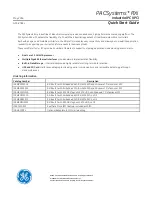
Maintenance
Waukesha Cherry-Burrell
Page 44
95-03057
October 2005
Scraper Blade Maintenance
Blade Inspection
The blades should be inspected for wear and signs of
fatigue or cracking at the pin location and should be
replaced if damage has occurred. Failure to replace
damaged blades may result in breakage, which can
damage other blades or the heat transfer tube, and result in
blade particles in the product.
CAUTION:
High concentrations of acid or caustic
should be avoided if plastic scraper blades are used.
Cleaners should be compatible with the elastomers
in the heat exchanger.
Scraper Blade Removal & Replacement
1. Scraper blades are removed by lifting up and pulling
them from the pins. PEEK Blades have a locking
groove. After lifting, push to the right before pulling
them from the pins.
NOTE:
Blades should be kept in the same position on
mutator shaft throughout life of blade. Make sure blades
are removed and reinstalled in the same location on the
shaft.
Reverse this procedure for installation. Make sure beveled
edge is installed toward shaft.
Scraper Blade Wear
Worn blades reduce heat transfer efficiency and can cause
excessive wear on the product tube wall.
As the scraper blades scrape across the interior of the heat
exchanger tube, they wear into the contour of the tube. A
flat surface called the heel and a burr or feathered edge
develops at the contact area on the side of the blade that is
against the tube wall. See Figure 20.
The blades must be maintained to achieve maximum
performance. When the heel of the blade reaches a
maximum of 1/16" (1.6 mm) on metal blades or 1/8" (3.2
mm) on plastic blades, they must be replaced or re-
sharpened.
Blade Sharpening
Scraper blades can be sharpened by several methods,
depending on the blade material.
The best method utilizes a high speed 45° cutter and
fixture that keeps the backside of the blade perpendicular
to the cutting edge. The cutting edge of the blade should
be parallel to the back surface of the blade within 1/64".
A new universal blade is 2 inches wide by 6 inches long.
For mutator shafts that are 4-1/2 inches in diameter or
larger, the blade should not be sharpened to a blade width
of less than 1-3/8 inches.
For mutator shafts that are 4 inches in diameter, the blade
should not be sharpened to a blade width of less than
1-1/2 inches.
Stainless steel blades for the 5-1/4 inch mutator shafts are
1-9/16 x 23-29/32. The minimum width after sharpening is
1-3/8 inches and the sharpening edge is at a 15-degree
angle.
Figure 19 - Scraper Blade Removal
Figure 20 - Blade Wear and Sharpening
Summary of Contents for Waukesha Cherry-Burrell Votator II
Page 64: ...Parts Lists Waukesha Cherry Burrell Page 64 95 03057 October 2005 Single Mechanical Seal...
Page 66: ...Parts Lists Waukesha Cherry Burrell Page 66 95 03057 October 2005 Double Mechanical Seal...
Page 75: ...Waukesha Cherry Burrell Addendum October 2005 95 03057 Page75 Vertical Refrigeration System...
Page 76: ...Addendum Waukesha Cherry Burrell Page 76 95 03057 October 2005 Horizontal Frame Options...
Page 78: ...Addendum Waukesha Cherry Burrell Page 78 95 03057 October 2005 Vertical Hydraulic Schematic...
Page 83: ......
















































